POMEGRANATE - PESTS
Pest Management & Diagnosis!
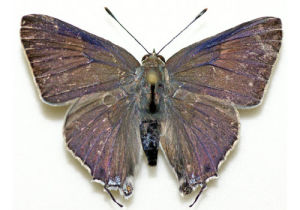
Pomegranate butterfly, Deudorix isocrates (Fab.)
Symptoms :
The conspicuous symptoms of damage are offensive smell and excreta of caterpillars oozing out of the entry holes, with the excreta found stuck. The affected fruits eventually fall down.
Remove and destroy all the affected fruits (fruits with exit holes).
Control:
Spray Decamethrin @ 1ml/litre at the time when more than 50% fruits have set. Repeat after two weeks with carbaryl @ 4 g/L or Fenvalerate @ 1ml/litre in non-rainy season. Quinalphos @ 2.5ml/litre is also effective. The number of sprays depends on severity of infestation.
· Remove flowering weeds especially of compositae family.
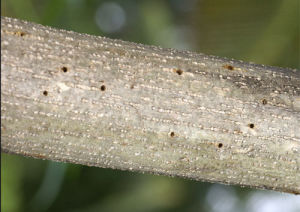
Shot hole borer Xyleborus sp. (Scolytidae: Coleoptera)
Symptoms :
This is becoming a major pest nowadays on pomegranate in Karnataka. Early diagnosis with symptoms is a must. Hence, regular visit to orchards by growers is suggested. Signs of lateral branch yellowing to quick drying of full tree, should be immediately brought to notice of specialists and treatments should be undertaken as follows:
Control:
· Drench soil around main trunk with a mixture of chlorpyriphos 2.5 ml with altering recommended fungicides (carbendazim 1g/litre or propiconazole 2ml/litre) at monthly intervals.
If pest is severe, repeat the above drenching after a month.
If infestation is low, drench with Azadirachtin (0.15%) 3ml/litre around main trunk 2-3 litres of mixture/tree with either of the above fungicides.
Avoid water logging and keep soil raked and aerated.
Infested trees should be uprooted and burnt, especially the root zone.
Pits of uprooted trees should be treated with chlorpyrifos 2.5 ml/litre, by thoroughly drenching.
Drench soil with chlorpyriphos 2.5ml/litre around all un-infested tress prophylactically once in six months, followed by a spray on trees with Quinalphos 2.5ml/litre, followed by Azadirachtin 1500 ppm 3 ml/litre. Avoid leaving infested trees in field after uprooting.
In case of nematode occurrence, need based application of either phorate 25g/ plant or carbofuran 40g/plant to the basins have to be supplemented to bring down nematode population.
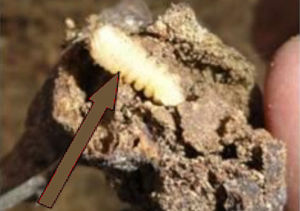
Stem boring beetles, Koilosternia spinator (Fab.), Zeuzera coffeae
Symptoms :
The grubs bore into the trunk, primary and secondary branches. The bored stem show yellowing followed by drying, leading to dieback.
Control:
Detect early infestation by periodically looking out for drying branches.
Examine branch for holes/ excreta/ gummosis. If detected, inject using a disposable syringe (without needle) 5-10ml of dichlorvos 2ml/litre and seal the hole with clay.
Cut out the drying portion of the branch and swab copper-oxy chloride 50% WP on cut end. Spray all surrounding trees with Quinalphos 2.5ml/litre or chlorpyrifos 2.5 ml/litre.
It is good to give a prophylactic swab during May/ June on the main trunk with following mixture: Carbaryl (50WP) 6g + Copper-oxy-chloride (50% WP) 10g + (sticker 1 ml + Neem oil 1 ml) (all per litre of water).

Thrips, Rhipiphorothirps cruentatus Hood, Scirtothrips dorsalisHood
Symptoms :
Thrips rasp tender fruits; causing scab on them and thereby reducing market and export value. Thrips infestation is often seen on leaves and also on young fruits causing characteristic scab on fruits
Control:
Spraying dimethoate 2ml/litre or fipronil 1 ml/litre or imidacloprid 0.3ml/litre or thiamethoxam 0.3g/litre prior to flowering is important.
If serious, a spray of acephate 1.5 g/litre should be repeated after fruit set. The subsequent sprays for borer limit thrips build-up.
Keeping the basins clean also reduces damage due to thrips.
A follow-up spray of Azadirachtin @ 3ml/litre is useful.
The numbers of sprays depend on the pest severity.
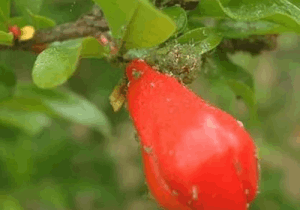
Pomegranate aphid, Aphis punicae Shinji
Symptoms :
Sap sucking by aphids lead to shriveling of shoots. If serious, honey-dew accumulates on leaves and sooty mold develops affecting photosynthesis.
Control:
Spary dimethoate 2ml/litre or imidacloprid 0.3ml/litre or acetamiprid 0.3g/litre as new shoots emerge. If predators like syrphids and coccinellids are found, delay spraying and in some cases, natural enemies sufficiently suppress the aphids

Mealy Bugs
Symptoms :
Many mealybugs like Icerya purchasi Maskell, Planococcus sp., Pinnaspis sp., Maconellicoccus hirsutus (Green) etc have been reported on pomegranate. Prune the affected parts of the plant and destroy.
Control:
Spray chlorpyriphos 2.5 ml/litre + dichlorvos 1ml/litre after pruning infested parts.
If on a small scale, release Cryptolaemus montrouzieri Mulsant near the site of infestation
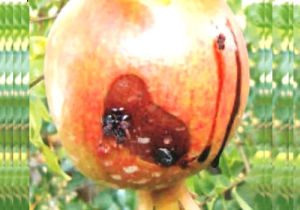
Fruit sucking moth, Othreis sp
Symptoms :
Adult moths of both sexes cause damage to fully ripe fruits by piercing and sucking the juice usually during night times. Damaged fruits are completely unmarketable and must be removed at packing to avoid contamination of sound product.
Management:
The adult moths prefer to feed on ripe guava or banana fruits over pomegranate. These bait fruits can be tied to wooden stakes singly using thread. Commence baiting during fag end of harvest as maximum damage is been caused to mature fruits. The fruit baits can be erected in the borders where moth damage is severe @ 50 bait fruits per hectare. This baiting and trapping is found to be an effective method for controlling the fruit sucking moth damage. In areas where fruit sucking moth poses serious problem using regular use of fruit baits or erection of fly-proof netting around the trees or orchard gives the best control
Harvesting and yield:
Yield level varies from 8.0 to 15 t / ha. Fruits attain maturity in about 150 – 180 days from flowering depending upon the variety. A mature fruit gives a characteristic metallic sound when pressed gently and attains colour specific to the variety. Fruits can be graded depending up on the size (weight) into different categories as stated below:
a) Super size : Fruit weight > 750g
b) King size : Fruit weight 500 – 700 g
c) Queens Size : Fruit weight 400 – 500 g
d) Prince Size : Fruit weight 300 – 400 g.
